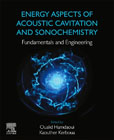
Energy Aspects of Acoustic Cavitation and Sonochemistry: Fundamentals and Engineering
Hamdaoui, Oualid
Kerboua, Kaouther
Energy Aspects of Acoustic Cavitation and Sonochemistry: Fundamentals and Engineering covers topics ranging from fundamental modeling to up-scaled experiments. The book relates acoustic cavitation and its intrinsic energy balance to macroscopic physical and chemical events that are analyzed from an energetic perspective. Outcomes are directly projected into practical applications and technological assessments covering energy consumption, thermal dissipation, and energy efficiency of a diverse set of applications in mixed phase synthesis, environmental remediation and materials chemistry. Special interest is dedicated to the sonochemical production of hydrogen and its energetic dimensions. Due to the sensitive energy balance that governs this process, this is seen as a green process for the production of future energy carriers. Provides a concise and detailed description of energy conversion and exchange within the single acoustic cavitation bubble and bubble population, accompanying physical and chemical effects Features a comprehensive approach that is supported by experiments and the modeling of energy concentration within the sonochemical reactor, jointly with energy dissipation and damping phenomenon Gives a clear definition of energy efficiency metrics of industrial sono-processes and their application to the main emergent industrial fields harnessing acoustic cavitation and sonochemistry, notably for the production of hydrogen INDICE: Part I. The single acoustic cavitation bubble as an energetic system: qualitative and quantitative assessments 1. Single acoustic cavitation bubble and energy concentration concept 2. Bubble Oscillation: From stability to chaos, an energetic reading 3. The energy forms and energy conversion 4. Physical effects and associated energy release 5. Sonochemical reactions, when, where and how? Part II. The bubble population: An analytic view into mutual forces and allied energy exchange 6. The Bjerknes forces and acoustic radiation energy 7. Bubbles resonance 8. Damping mechanisms 9. An energetic approach of bubble coalescence and fragmentation 10. Energy controlling mechanisms: Relationship with operational conditions Part III. Ultrasound assisted processes, sonochemical reactors and energy efficiency 11. Energy efficiency assessment: calorimetry and beyond 12. Sources of dissipation: an outlook into the effects of operational conditions 13. Technological designs and energy efficiency: the optimal paths Part IV. Green, sustainable and benign by design process? The place and perspective of ultrasound assisted processes and sonochemistry in industrial applications based on energy efficiency 14. Acoustic cavitation and sonochemistry in industry: State of the art 15. Scaling up challenges and energy barrier 16. The sonochemical production of hydrogen: Energy efficiency for the generation of an energy carrier 17. Future trends and promising pathways of industrial sono-processes
- ISBN: 978-0-323-91937-1
- Editorial: Elsevier
- Encuadernacion: Rústica
- Páginas: 462
- Fecha Publicación: 01/08/2022
- Nº Volúmenes: 1
- Idioma: Inglés
